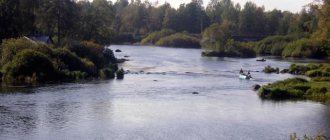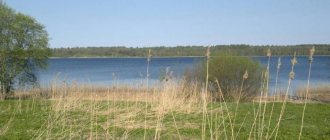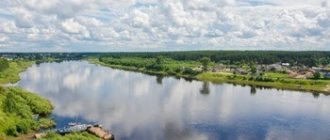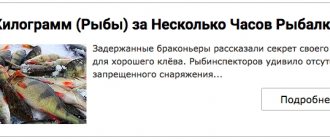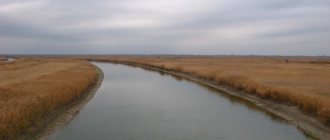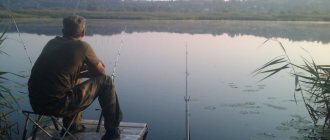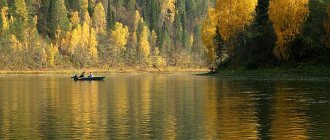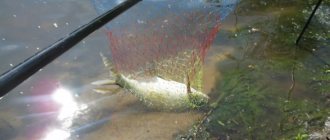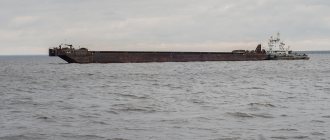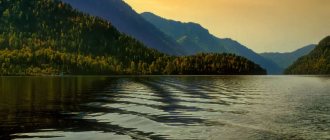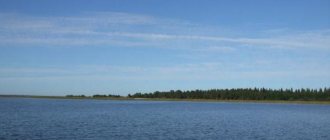Where can you go fishing? Secret place. Vuoksa.
Many people ask the question where is the best place to go fishing? Is there a place on the river where the bite is constant, the water is calm and no water equipment cuts through it?
Every fisherman knows the best place to stop, but not everyone wants to share this secret, sometimes simply out of fear that someone will steal his secret place, sometimes out of caution.
After all, everyone knows that experienced fishermen do not look for easy ways. In addition, having thoroughly browsed the pages of the Internet, it is possible to discover the disclosure of some secrets that I would like to tell you about.
The Vuoksa River originates from Finnish waters, namely Lake Saimaa. Starting from the Baryshevsky district, the bed of the not so wide river widens significantly, thereby turning into an elongated smooth lake, the width of which is approximately 2.5 km.
And along the entire length of the river, in some places the crowd of people reaches its climax, while in others it is completely deserted. This is a simple pattern.
Therefore, if you prefer secluded fishing, you should, armed with a map, carefully study the river along its entire length, and, having visited several places near the river, choose the most suitable one for yourself.
Vuoksa is a busy moving river; you can stop for fishing either in a tent or in a comfortable house or cottage, offered for rent by specialized bases or grounds.
In any case, you will have successful fishing.
Only after several trips, lasting maybe a month, or even a year, will you feel connected with nature.
Your inner feelings will help you understand that the place you have chosen is exactly the right one. As a rule, in such places you like everything and even the fish bite better than anywhere else.
You can easily study what kind of fish is found in a certain area using a map and the Internet. Based on this, select all the necessary gear, bait and additional accessories for fishing.
Vuoksa: general information
Vuoksa is a wide river almost 150 km long that flows through Finland and the Leningrad region of Russia. It begins in the Finnish Lake Saimaa, along its route there are several hydroelectric power stations - two for each state.
Flowing through the village of Baryshevo, the river expands to 2.5 km, turning into an elongated lake. Near Losevo, its “prototype”, the Vuoksa-virt River, flows into the Vuoksa. The latter flows out of Lake Balakhanovskoye. In the same area, the river is divided into two branches:
- The Yuzhny flows into Lake Ladoga and is the second largest tributary.
- The Northern flows into a number of small lakes.
The history of Vuoksa is quite curious: the river managed to change its course several times throughout its existence. Initially it had two channels - western and eastern. The former was a busy trade route in the 11th-13th centuries, but gradually it began to dry up and today consists of small lakes.
In addition to the river, there is Lake Vuoksa, a popular place among fishermen. It is located before the river flows into Ladoga. It boasts a large number of islands, villages and tourist centers on the shore. Most of the river flows along picturesque forest areas.
For fishermen, Vuoksa will be interesting for its rich fauna: here you can find any fish of the Ladoga basin. Fishing takes place for ide, whitefish, trout, bream, dace, burbot, roach, rudd, catfish, pike perch, pike, grayling. But most often the target of sportsmen and amateurs is large salmon.
Differences between fishing in the Leningrad region on Vuoksa
In the reservoirs of the Leningrad region, the variety of fish is quite wide, about 60 species of commercial fish, some of which are called anadromous - these are those that do not stay in the river for a long time, but make their way from the sea to the river for the spawning period.
The other part is permanent, non-replaceable inhabitants of reservoirs, and the third is sea inhabitants.
Some migratory fish include:
- Baltic sturgeon;
- salmon;
- whitefish;
- smelt;
- river eel.
So, in some there are even trout, so with the right choice of place and selection of gear, you can eventually enjoy the delicacy. The choice of places is quite large.
Anyone who wants to spend a weekend fishing will find a secluded place for themselves.
Since you can fish on Vuoksa all year round, you can find here:
- pike;
- trout;
- salmon;
- zander;
- ide;
- chub;
- whitefish
Vuoksa is a favorite fishing place for those who use spinning rods or fly fishing gear.
In Vuoksi you can find fish of almost any species from the entire North-Western region. All you need to do is find a suitable place for a certain type of fish.
Thus, in the channel between lakes Virta and Suvanta there are salmon and trout. Another interesting place that attracts the attention of tourists is Taipolen-Ioki. In addition to trout and salmon, in summer you can find pike perch, pike, and lake trout here.
Fishing on Lake Vuoksa
Local residents believe that Lake Vuoksa is the fishiest in the entire region. Most often perch and pike are caught here. It is especially good to go perch fishing in winter. Rare species of fish, such as salmon, are also found in the lake. But its fishing on Vuoksi is officially prohibited. In total, the lake is home to 29 species of fish. Vuoksa is a fairly popular fishing spot among residents of St. Petersburg. Therefore, there are quite a lot of people who want to go fishing here. However, in recent years, fishermen have complained about a decrease in the number of fish.
On Vuoksi you can fish both from the shore and from a boat, using different types of gear. The lake has vast open spaces, channels, calm bays, and reed pools. When planning fishing, you should take into account the complex topography of the lake bottom and the variability of local weather. In summer there can be strong storms on the lake, so don’t forget about water safety. Ice on the lake sets in in December, and its melting ends in May.
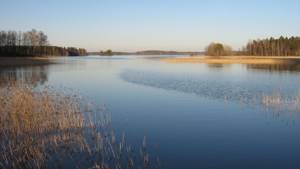
© Dmitry Grishin
Features of fishing on the Vuoksa system of rivers and lakes
On Vuoska in the Leningrad region you can go fishing in several places, since the river has its own well-coordinated system.
These include:
- Gateway Rattle. Fans of winter fishing will appreciate the closure of the fishing season at the end of autumn at the Gremuchiy lock. Pike and burbot bite best at this time. The catch, although not very rich, is worth the effort.
- Bright. You can stay in the bright city at the tourist base of the same name by renting a room or a cottage. Fishing here is a pleasure; the fishing base provides a full range of additional services. Almost all the inhabitants of Vuoks are caught.
- Baryshevo. Fishermen believe that Baryshevo is an interesting solution when choosing a fishing spot on Vuoksa. If we talk about the peculiarities of fishing in this region, then in the hot summer season it is most appropriate to catch a predator on a path along dumps at a depth of three, four or more meters.
Among the potential trophies it should be noted:
- asp;
- ide;
- bream;
- roach;
- pike perch;
- Girona;
- perch;
- pike.
Features of fishing on Vuoksa by fishing season
Depending on the time of year, you need to be careful when going to Vuoksu:
- In spring , Vuoksa is full of anglers of all skill levels. Ruffed grouse going to spawn attracts both amateurs and professionals. You can count on chub, ide, roach, perch, burbot, pike perch, pike, salmon and raw fish are also found. However, due to melting ice, fishing can be quite dangerous: ice floes and mud on the shore are not to everyone's taste.
- In summer, the bite remains good. Changing species of fish allow you to use a variety of baits and fishing rods. It is best to go out in cloudy and windless weather; the fish bite well at dawn. As a trophy there will be roach, crucian carp, whitefish, carp, rudd, burbot, perch, catfish, ide and almost all types of available fish.
- In the fall you can practice sport fishing. The fish is active as in the spring, but for a different reason - it begins to gain fat for the winter. Large specimens are more common, and with the first snow the ide begins to become active. In addition to it, pike, bleak, crucian carp, perch, catfish, roach, and burbot also bite.
- In winter , life doesn’t stop either, however, you need to focus on the weather and terrain: areas with weak currents and light frost are suitable. Strong winds and cloudy mornings are unlikely to bring much prey. Catfish, roach, pike, crucian carp and perch will bite. It is necessary to clearly calculate your strength, since fishing will take place on ice.
Fishing on Vuoksi on your own, with friends or with the whole family
With whom and no matter how you relax, fishing on Vuoksi will definitely bring a lot of impressions.
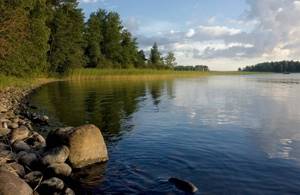
Modern accommodation conditions allow you to relax on Vuoksa on your own, staying in a camping town or on a wild coast, taking your own tent with you, fishing in a noisy company of friends, staying in a comfortable cottage, spending a weekend with the whole family, renting a country house or estate.
No matter how you want to relax - all this is possible and accessible, moreover, impressionable and interesting.
Having looked through the accommodation offers on the Internet, no one will be left without an overnight stay.
Many people judge by the area where the bases are located and are afraid to even imagine what the cost of living in a fishing area is.
It is worth saying that many of the complexes set fairly diplomatic prices, making their services accessible to everyone.
Comfort
Every person wants to relax in comfort. But everyone’s concept of comfort is different. Some people cannot live without a double bed even if they go out for one day, while others are alien to the majestic attitude - they cannot imagine life without a tent by the river.
Therefore, the type and method of placement is an individual thing for each person.
There are several categories of accommodation for vacationers on Vuoksi:
- VIP class bases;
- bases of the “standard” type;
- "economy" type bases;
- camping recreation centers.
Rest
Lake Vuoksa is a popular holiday destination. Travel companies organize tours around the Vuoksa River basin. On the shores of the lake, in the nearest villages, there are many recreation centers. Popular ones are “Youth”, “Plotvichkina”, country club “Yarkoe”. Vacationers come to the lake on their own. In summer, on all the large islands you can see lovers of “wild” outdoor recreation. There are equipped places for tents on Vuoksa; you can rent equipment.
While relaxing on Vuoksa, you must not forget about the rules of behavior in nature. Do not leave trash behind, and be careful when lighting fires.
© Konstantin Nikiforov
Nature
Despite scientific and technological progress and modern construction technologies, people living near the river know that preserving the natural principle is one of human qualities.
Therefore, the construction of wooden houses and cottages on the banks of the river became unique. This placement option is the most favorable for the environment and introduces the least amount of disturbing factors into the ecosystem.
The nature of Vuoks in some places has not yet been touched by human hand, it amazes the imagination at first glance.
It is thanks to the diversity of reservoirs and its composition that Vuoksa is so rich in various types of fish, and this is what allows fishing on Vuoksa to be turned into an exciting, multifaceted activity accessible even to fishing beginners.
The well-formed riverbed of Vuoksa for recreation attracts so many fishermen and lovers of outdoor recreation. But all the beauty of nature lies in the walking routes along the banks of the river, especially in the summer.
Diversity
Paid fishing for love in an artificial reservoir - this is an environment created by people. On Vuoksa, most of what is visible to the human eye was created by nature itself.
Of course, the number of fish caught depends only on the fisherman himself and his success, but in any case, it is only possible not to catch at least one fish if you have not uncovered your fishing rods.
The unique hydraulic system of Vuoksa allows you to choose any place you like near the river. Nature has created a complex not made by man, consisting of the river itself and the number of lakes it forms.
In addition to quiet lakes, bays and harbors, extreme fishing enthusiasts will find rapids and spillways. It is this diversity that contributes to the emergence of such a variety of fish.
On Vuoksi you can fish both from the shore and from a motor boat or speedboat.
Fans of calm, measured fishing and those who prefer active adrenaline-filled types of fishing, using all kinds of gear and fishing elements, will find something for themselves.
superkaras.ru
We will talk about fishing that took place from July 10 to 14. I, together with my colleague, decided to go fishing on Vuoksa, the venue for this action was a place between the village of Baryshevo and Cape Gremuchiy, opposite Skvorechny Island. The place for fishing was not chosen by chance, because... I have been fishing on this section of the river constantly and successfully for four years. We will talk about fishing that took place from July 10 to 14. I, together with my colleague, decided to go fishing on Vuoksa, the venue for this action was a place between the village of Baryshevo and Cape Gremuchiy, opposite Skvorechny Island. The place for fishing was not chosen by chance, because... I have been fishing on this section of the river constantly and successfully for four years. Having arrived and settled in place, we made our first swim in the hope of catching pike and perch. The place where the above were caught was the flooded side of Skvorechny Island. The constantly flooded coast of the island was a very attractive place for spinning. But we didn’t stay in this section of the reservoir for long (about an hour), due to the lack of bites. It was decided to go downstream (along the island) and try ourselves as specialists in jig fishing. Moreover, the rocky shore of Skvorechny had a rocky bottom and depths of up to 15 meters. Fasten the twisters and let's hit the bottom. I was lucky, at the very first wiring there was a dull poke. Judging by the looming heaviness, it became clear that the specimen at the other end of the cord was clearly pulling a kilogram, or even more.
After a short pumping, a kilogram pike perch was brought to light. We didn't catch anything else that day. On the second day we decided to swim to the cape. The idea is noble, but as it turned out later, stupid. We had to walk 1.5 kilometers upstream. The weather was clearly against our voyage. The sun burned mercilessly. Along the way we stopped to take a break and fish all the most promising places. At one of these stops, we caught one string and a couple of small fish, and so, we swam to Gremuchy, didn’t catch a damn thing, we just watched how trout were fed in the local reserve. Tired and burned, they floated back to their native land. The third day was the most successful. We decided to swim out in the morning and fish on donkeys. There were a couple of donks with a worm and another one with live bait. About 15 minutes after setting the rods in standby mode, the first bite followed, and a very bold one at that. The resistance was furious. I thought there was something huge there, but it turned out that it was not very big, but very noble and “red.” It was a small trout. There was joy... After about 10 minutes the live bait worked, and my colleague, Andryukha, began lifting something very heavy. The fishing rod twisted into a parabola. He lifted it very long and diligently. As soon as the heavyweight appeared on the surface of the water, and it was a huge pike perch, I, without wasting a minute, sharply hooked it. It turned out that this specimen weighed 2.5 kilograms. After catching the pike perch, I caught a one-kilogram bream, but there’s no need to talk about it, because... Surely many people managed to extract a kilo's worth of bream from the water... Then the weather turned bad. The rain and wind were not particularly conducive to going out on the water, so the remaining reserve days were spent picking berries, mushrooms and catching crucian carp in the lake, which is located 50 meters from the “big water”. In general, we had a good rest...
Author: Shadrap (Butorin Roman)
www.spoon.spb.ru
I never managed to fall asleep before going fishing. I met the alarm clock set for 2:15 am with open eyes. I’m writing a message on Viber to my godfather about the climb and going after him. Two of our comrades are already waiting for us at the place. For some reason they arrived there the night before.
An hour and a half drive and we are there. Fog, +4 degrees, time five in the morning. On the shore there are already a bunch of fishermen who have filled the entire shore with donks. We call our comrades so that they come for us from the island and assemble the second boat. It took about an hour to get ready. And here we are on the water.
Of the four of us, three were there for the first time. Therefore, we trusted someone who has been vacationing in this place for 16 years. We swam into the reeds into the peals. The depth is one and a half to two meters. Grass in places. Wiring can be done, but it is not always clean.
At the end of four hours of fishing, there was only one pencil and a boat exit, which greatly spoiled the mood. So much water, but no fish. It's time for lunch, it's 11 o'clock. An hour for lunch, and again on the water. After all, it’s already home in the evening.
We swam again into the peals. We fished a couple of old places. Everything is past. I decide to change the place radically. We leave the reeds and stand in an open area. It's all over again. Only a coincidence of circumstances and a change of shore (we moved to the shady side) brought us the first 700-800 gram pike.
The mood became a little better. We decided to fish the entire shore on the shady side. As a result of fishing, I have four pieces and a good catch, my godfather has one pike and a couple of hits. The third comrade has one exit at the boat. The fourth generally slept on the shore after lunch.
Time - four hours. Taking into account the long preparations and the road, we decided to stop... I can’t stand trips for one day. More fuss than relaxation.
In general, every year the situation with catching predators is getting worse. What this is connected with is unclear. But definitely not with the weather. At that time, when I was just getting acquainted with spinning fishing, I left almost every reservoir with only a couple of spinners and left with a catch.
Time has passed, experience has increased, the arsenal of gear has expanded, and if something is missing, it can almost always be found in your partner’s arsenal. We no longer fish from the shore, but on a boat and with an echo sounder. Everything seems to be there for fishing.
But every year the observations and results on fish are getting worse. And it's not a matter of appetite. I'm not a super fisherman. But the elementary minimum from the reservoir is clear in advance.
It is interesting to read the opinion on this matter of fishermen from the North-West, from St. Petersburg and Karelia. Either things are really getting worse, or my self-esteem is going to hit rock bottom...
gdekluet.ru
Fishing on Vuoksa in the Leningrad region
Vuoksa is a wide river. Its origins are in Lake Saimaa in Finland. In the village of Baryshevo (Russia), the river overflows, turning into a lake, which in the village of Losevo is reborn into the Losevskaya channel, then flows into Lake Sukhodolskoye.
- What is? ↓
- Recreation centers ↓
- What kind of fish are there? ↓
- Advantages and disadvantages of the place ↓
- About the reservoir ↓
- Stocking reservoirs with fish ↓
- Reviews ↓
- Conclusion ↓
You can get to Vuoksi either by public transport or by car. The distance from the reservoir to the cultural capital is 140 km.
Electric trains run from pl. Lenin and from metro station Devyatkino. Buses from Devyatkino. By car you can travel along the Priozerskoye Highway along the villages of Losevo, Malaya Gorka and Melnichnye Ruchi.
What is?
Vuoksa is a body of water with an area of 108 square kilometers.
Since the pool is large, there are several “fishing spots”:
- Gluboky Bay;
- Mannerheim Line;
- Yegorych parking lot;
- Stone pier;
- Islets;
- Northern reed;
- Trout Bay;
For lovers of architecture and sights, there is also something to see. The beautiful church, built in 1912 and restored in 2010, is one of the most spectacular buildings on the Karelian Isthmus.
There is also the opportunity to take a boat trip, fish under the supervision of professionals, rent a cottage or room and have a good rest with the whole family.
Recreation centers
How to increase your fish catch?
Over 7 years of active fishing, I have found dozens of ways to improve the bite. Here are the most effective ones:
- Bite activator. This addition of their dry blood is the strongest lure for fish in cold and warm water. Discussion of the bite activator “Hungry Fish”.
- Increased gear sensitivity. Read the appropriate manuals for your specific type of gear.
- Pheromone-based lures.
What kind of fish are there?
In the area of the lake and river there are 30 species of different aquatic animals:
- breams;
- saberfish;
- loaches: Arctic, baleen;
- barbel;
- minnows;
- dace;
- whitefish;
- carp: regular, naked, mirror;
- smelt;
- white-eyes;
- salmon;
- palia;
- burbot;
- perches;
- minnows;
- trout: brook, lake;
- vendace;
- zander;
- asps;
- blues;
- roaches;
- bleaks;
- bream;
- grayling;
- silver bream;
- pike;
Advantages and disadvantages of the place
The proximity of the city of Priozersk with its plants and factories on the eastern shore of the lake has a bad effect on the ecology of the area, but this is a small minus.
The advantages of fishing on Vuoksi are that there are a lot of different fish there, you can choose a place - the water area is quite wide.
Recreation conditions on Vuoksi are very diverse - you can come with tents as savages, you can rent a hotel room, rent a cottage, etc. It all depends only on desires and the amount of money.
About the reservoir
Vuoksa is a water system that includes a system of lakes in two countries (Russia, Finland), the largest river on the Karelian Isthmus.
It originates in Lake Saimaa, whose height is 74 m above sea level, and flows into Lake Ladoga in two branches: in the north near Priozersk and in the south through Lake Sukhodolskoye (length 32 km, width reaches 3-4 km) and the Burnaya River.
In essence, it is an extensive system of flowing lakes connected by multiple branches and channels.
The length of the river is 156 km (of which 143 km is on Russian territory), its water coverage is approximately 52 thousand square kilometers. The bed of the water system has changed more than once.
Previously, Lake Sukhodolskoye drained excess water into Vuoksa, but in the spring of 1818 the waters of the lake destroyed the esker ridge that separated it from Lake Ladoga, its level dropped by 7 m, and Vuoksa changed its movement.
The northern channel of Vuoksa, through which the entire volume of water flowed until 1857, has dried up to varying degrees in some places. This branch contains two large lakes - Balakhanovskoye and Nizhnyaya Vuoksa, connected by a long narrow watercourse.
In the upper reaches, the Salpausselkä hill (Finnish: Salpausselka) runs across, starting in Finland with the European Imatra Falls. 4 hydroelectric power stations were built on the river: 2 in Finland and 2 in Russia (Svetogorsk and Lesogorsk).
Stocking reservoirs with fish
Every year, approximately 200,000 lake trout are released into the Vuoksa River bed. The age of the fish is about 2 years. The size of this fish is acceptable for catching.
Trout is in demand among fishermen to a greater extent than lake salmon, because usually assigned to a specific location.
Lake trout fry are more likely than salmon fry to remain near stocking sites.
Lake trout released into the water slides, which are suitable in size for catching, also hold up well in current waters, so they are released in large volumes, and for the purpose of recreational fishing.
When the eggs in these incubator boxes mature to the eye formation phase, they are taken to the rapids, where the fry will be able to survive.
Having hatched from the eggs, the fry end up on the tray of a mini-incubator, where they live off the yolk sac. When the fry are large enough, they swim out of the incubators.
Following the example of lake salmon, the method of cutting off the adipose fin is used in lakes Saimaa and Pielinen. This is how they try to sort fish released for fishing from fish that need to be preserved. Fish with a cut off fin are intended for fishing.
Reviews
Fishing on Vuoksa - ring fishing.
I have tried almost everything in terms of fishing methods (float and bottom fishing rods, spinning rod and line, girders, circles (pegs), nets, etc. I want to share some methods of fishing on Vuoksa.
Ring fishing is described in the book by V.B. Sabunaev “Sports Fishing” Leninizdat, 1972. Recently, especially on the Volga, various options for fishing with a bottom fishing rod with a ring have become widespread. You can fish this way from a boat, rafts, or bridges. The main part of the gear is a lead ring weighing from 30 to 80 grams. The weight depends on the depth and strength of the current at the fishing site. The most successful option for equipment is this: a hook is tied to a vein leash with a diameter of 0.25-0.3 mm and a length of about 1.5 m at one end, and a carabiner at the other. The main vein line with a diameter of 0.35-0.4 mm is threaded into the hole in the ring and tied to the other eye of the carbine so that the ring acts as a sliding sinker. The carbine, of course, should not slip into the hole in the ring.
When starting fishing, first on a vein with a diameter of 07-0.8 mm, lower the net with bait. Then the hook is baited and the ring is inserted through the slot onto the vein leading to the feeder. You can fish by holding the line in your hands, but it is more convenient to use a short fishing rod or a spinning reel. Since with this method of fishing the bait is located exactly on the stream carrying food particles, bites occur more often than when fishing with a regular bottom fishing rod. The disadvantage of this method is that it is hard to fish, which is why there are more fish kills. It is advisable to have a landing net with a long handle, since the fish cannot be brought closer to the boat with a rod than the length of the leash. The picture given by the author does not correspond to what he is talking about. In subsequent editions of the book, Sabunaev removed this description and drawing from the book. However, it is in the articles. This can be viewed on the fishing website of the city of Vyksa. Here in this picture the ring is shown more clearly.
I would not be so categorical that fine mesh feeders are bad. Fishermen everywhere adapt this method of fishing to suit their capabilities. For example, I used a homemade fishing rod, if this device can be called that, in the form of a small stick, at one end of which there was a spring made of steel wire with a rubber line holder at the end, made of two washers, compressed by a screw; the other end of the stick was stuck into the hole for the oarlock. A small reel was attached to it, and when the brake was removed, the ring removed the line from it. After installing the ring on the feeder, I pulled the fishing line and inserted it into the slot of the holder. You can do without a reel by using a reel. I agree with the fishermen that the most difficult thing in this fishing is landing, especially bream. However, I made the leash longer, up to 2 meters, and after pulling the ring and the fish to the boat, I intercepted the line after the ring, did not rush to take it with a net, but loosened the tension of the line and let the fish “take a walk” and take a breath of air. And the specimens were sometimes respectable: bream 2.5-3 kg. It was easier with the ide; it hooked securely, and if it left, it did so with a leash. Fishing is truly exciting and effective. Documentary confirmation -
